In the ruins of a city that was once Rome’s neighbor, archaeologists last summer found a 1,000-pound lead coffin.
Who or what is inside is still a mystery, says Nicola Terrenato, the professor of classical studies who leads the project — the largest American dig in Italy in the past 50 years.
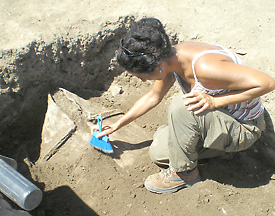
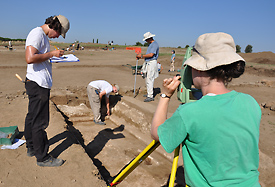
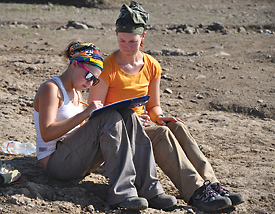
Above, Gabii project field director Anna Gallone, brushes dirt away from the lead-encased burial. Below, classical studies doctoral student Ivan Cangemi, Daven Reagan, classical studies researcher Matthew Harrington and University of North Carolina at Chapel Hill doctoral student Elizabeth Robinson record an architectural feature.All photos courtesy Jeffrey Becker, managing director of the Gabii project, McMaster University.
Above left, classical studies doctoral student Evelyn Adkins instructs undergraduate student Jessie Lipkowitz about documentation in the field.
The sarcophagus soon will be transported to the American Academy in Rome, where engineers will use heating techniques and tiny cameras in an effort to gain insights about the contents without breaking the coffin itself.
“We’re very excited about this find,” Terrenato says. “Romans as a rule were not buried in coffins to begin with and when they did use coffins, they were mostly wooden. There are only a handful of other examples from Italy of lead coffins from this age — the second, third or fourth century A.D. We know of virtually no others in this region.”
This one is especially unusual because of its size.
“It’s a sheet of lead folded onto itself an inch thick,” he says. “A thousand pounds of metal is an enormous amount of wealth in this era. To waste so much of it in a burial is pretty unusual.”
Was the deceased a soldier? A gladiator? A bishop? All are possibilities, some more remote than others, Terrenato says. Researchers will do their best to examine the bones and any “grave goods” or Christian symbols inside the container in an effort to make a determination.
“It’s hard to predict what’s inside, because it’s the only example of its kind in the area,” Terrenato says. “I’m trying to keep my hopes within reason.”
Human remains encased in lead coffins tend to be well preserved, if difficult to get to. Researchers want to avoid breaking into the coffin. The amount of force necessary to break through the lead likely would damage the contents. Instead, they first will use thermography and endoscopy. Thermography involves heating the coffin by a few degrees and monitoring the thermal response. Bones and any artifacts buried with them would have different thermal responses, Terrenato says. Endoscopy involves inserting a small camera into the coffin. But how well that works depends on how much dirt has found its way into the container over the centuries.
If these approaches fail, the researchers could turn to an MRI scan — an expensive option that would involve hauling the half-ton casket to a hospital.
The dig that unearthed this find started in summer 2009 and continues through 2013. Each year, around 75 researchers from around the nation and world, including a dozen U-M undergraduate students, spend two months on the project at the ancient city of Gabii.
Studying Gabii gives researchers a glimpse into pre-Roman life and offers clues to how early Italian cities formed. It also allows them broader access to more substantial archaeological layers or strata. In Rome, layers of civilization were built on top of each other, and archaeologists are not allowed to disturb them.
Indeed, Terrenato and others were surprised to find something as significant as this coffin so soon.
“The finding of the lead coffin was exhilarating,” says Allison Zarbo, a senior art history major who graduates this spring.
Students spent most of their time pick-axing, shoveling and manning the wheelbarrows, says Bailey Benson, a junior who is double majoring in classical archaeology and art history.
“By the end of the day, not even a 20-minute shower can remove all the dirt and grime you get covered in,” Benson says. “It’s hard but satisfying work. How many people can say they uncovered an ancient burial?”
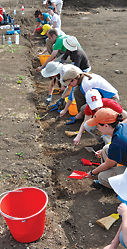 |
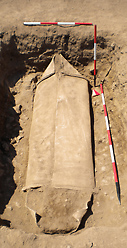 |
| Above left, troweling begins on the first day of excavations at Gabii, Italy, in June 2009. Archaeologists unearthed a lead coffin, above right, buried 11 miles east of Rome, an exceedingly rare find for this region in this time period. | |

